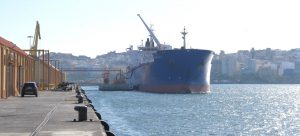Ceuta, Spain (PortSEurope) November 8, 2019 – The first discharge operation of Fueloil 0.5% low in sulfur VLSFO (Very Low Sulfur Fueloil) in the port of Ceuta took place last Friday, November 1, at the Poniente Dam, specifically in the new terraced dock of the 3rd alignment, intended for the reception of large ships for the transport of liquid bulk.
This new berthing infrastructure has made it possible for the operation to have been a success; since it has allowed to receive a ship of great draft and length, and now allowing Ceuta port to be more competitive by increasing its capacity for this type of operations that was previously limited to smaller vessels, which eliminates the traditional restriction that existed and penalized the cost of transporting petroleum products to our port.
The product has been stored in the DÚCAR I warehouse, and Vilma Oil was in charge of carrying out the unloading operations that lasted 35 hours. It should be noted that this first supply highlights the involvement of the Vilma Oil in the business of commercialization of bunkering in the port of Ceuta. Two months before the entry into force of the IMO-2020 regulations, the port of Ceuta is in a position to supply this fuel to ships that so demand.
This is the result of a process that began last February in London in the framework of the days promoted by IBIA on the occasion of the IP Week (International Petroleum Week).
The ship “Kurtulus”, from Turkey, was the first to receive this new fuel oil at the port facilities. The aforementioned vessel of 3,450 GT and 92.25 m in length was also supplied with 25 Tons of diesel from the same supplier and has been consigned by “Jose Salama & Co. Ltd”, local maritime agency.
In this way, the Ceuta port has expanded its product offering with the new VLSFO (Very Low Sulfur Fueloil) marine fuel marketed by Vilma Oil, which is another step in the strategy of the port of Ceuta to boost its positioning as a reference of fuel supply services to ships in the Strait, as it is a key geographic-logistic core for international navigation routes.
The month of October has ended, reaching the figure of 665,087 tons in supplies to ships, which represents a growth of 6.22%. To all this, we must add the ability to serve ships in the bay by barge, freeing up the limitations that may exist in response to those ships with the greatest displacement outside the docking port.
The Port Authority has long been developing commercial policies focused on capturing and increasing this traffic. In this sense, the necessary steps have been taken to achieve this objective through the increase of the supply capacity and the specialization of our services, which implies an increase in traffic and, therefore, an improvement in the port results.
Source of Information: PortSEurope.
